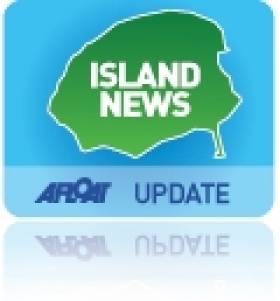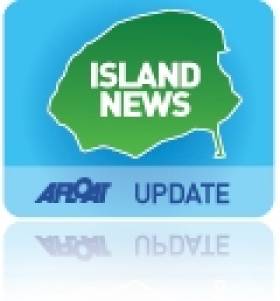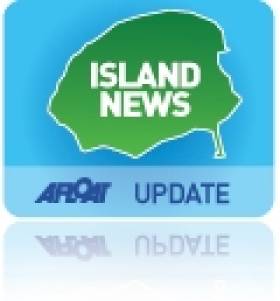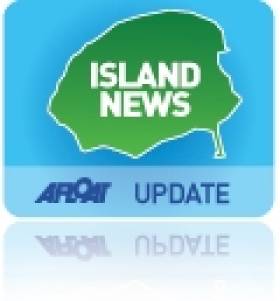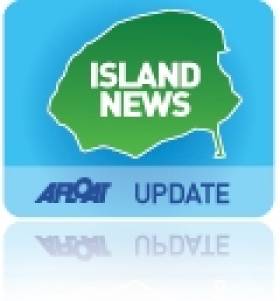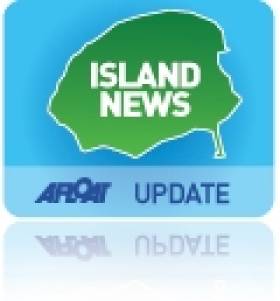Displaying items by tag: Island News
Steep Rise Set for Aran Islands Ferry Fares
#Ferries - Ferry fares for people travelling between Inis Mór in the Aran Islands and the mainland are set to almost double from tomorrow 1 February, as RTÉ News reports.
Island Ferries founder Paddy O'Brien has cited increased fuel costs for the sharp fare rise from €8 to €15 for return trips from the largest island in the group in Galway Bay.
Fares for residents of Inis Oírr and Inis Meáin are also rising by 25% after an increase in the annual subvention to provide ferry services to the islands sought by Island Ferries was not accepted by the Department of Arts, Heritage and the Gaeltacht.
The department had failed to secure any tenders for a public service contract on the Aran Islands ferry service, the present contracts for which expire today.
Helicopters Role in Proposed Upgrade of Dalkey Island Harbour
#DALKEY ISLAND FERRY – Up to 500 helicopter flights over an 8-day timeframe could be operating across the 300m wide Dalkey Sound, following proposed plans to upgrade the island's slipway harbour were unveiled last week, reports Jehan Ashmore.
According to consultants that carried out a report for Dun Laoghaire-Rathdown County Council, the proposed upgrade of the slipway, under a PART 8 Scheme, could see a site near Sorrento Point on Coliemore Road, as the desired landing location to load helicopters heading for the island with machine plant, equipment and materials.
Under the proposed development of up to 12 weeks to complete, work would involve raising the existing slipway to create a stepped top surface, widening of the existing channel, a new raised pier section with transitional steps, a handrail, mooring rings and an access ladder.
The consultants Malachy Walsh & Partners and Shaffrey Associate Architects have however indicated that Dun Laoghaire may be an alternative helicopter embarkation point. Total construction costs of the project are estimated at approximately €228,000, however should Dun Laoghaire be opted instead, this would double lift costs compared to Dalkey, adding about 84% to the overall helicopter costs.
The use of helicopter transportation is not new to the island, as in the early 1990's works on the island harbour also saw flights running back and forth to the grounds of the Dalkey Island Hotel, now occupied by a luxury apartment complex.
The consultant's report also adds that Dalkey Island is designated as a Special Protection Area (SPA) for roosting the common, artic & roseate tern species in accordance with the requirements of the EU Habitats Directive 1992, however given the scale and the location of the slipway works, the report concludes that a full appropriate assessment screening would not be required for the Dalkey SPA because it is considered not to have a significant effect on this site.
As previously reported on Afloat.ie the island has also been proposed as a Special Area of Conservation (SAC) as part of six Natura 2000 sites within Irish waters.
Plans and particulars of the proposed slipway upgrade of the Dalkey Island PART 8 Scheme development including timescale of public consultation process, can be found in greater detail to include downloadable PDF documents, by following this LINK.
Dublin Bay Protesters Demonstrate Against Dalkey Oil Exploration
#DALKEY ISLAND PROSPECT – Hardy swimmers and non-swimmers alike gathered at the Forty Foot bathing pool in Sandycove to voice their opposition to plans to allow exploration for oil in Dublin Bay off Dalkey, reports The Irish Times.
Last month the Department of the Environment awarded a foreshore licence to Providence Resources for exploratory drilling six kilometres from the Dalkey coast.
Providence has argued the project would be of significant economic benefit to Ireland with up to 40 per cent of profits from production accruing to the State. But groups such as Dublin Bay Solidarity, which organised the protest, have raised concerns about environmental issues and taxation, and have criticised the level of public consultation on the licence.
Afloat.ie adds that this latest protest held last Saturday at the popular bathing place in south Dublin Bay follows a protest outside the gates of Dail Eireann last week.
Close to 200 people attended to voice similar concerns, among them that a public inquiry was not granted and how our natural resources affect all the people of Ireland both locally as well as nationally, which needs to be highlighted and discussed.
Dalkey Island Forum
#DALKEY ISLAND – St. Patrick's Church of Ireland, Dalkey will be the venue for the Dalkey Island Forum, on 24 November between 9:30am - 1:30pm.
The forum will comprise of a panel of leading experts with presentations providing an overview of the unique archaeology, history and architectural features of this special island on the coast off south Co. Dublin.
The forum will also consider issues around access and management of the Island in the context of proposals by Dun Laoghaire Rathdown Council to 'improve' the landing place, while at the same time opposing moves to restore the historic ferry link from Coliemore Harbour.
Below is a list of speakers and topics arranged for the forum which is sponsored by Dalkey Civic Trust.
Dr Neill Brady, The Archaeological Diving Company: 'The Archaeology of Dalkey Island'
Dr Edel Bhreathnach, Michael O'Cleirigh Institute UCD: 'St Begnet and Dalkey's early Christian heritage'
Jason Bolton, Conservation Consultant: 'Conservation of the architectural heritage of the Dalkey Islands'
Darina Tully, Maritime Archaeologist: 'Dalkey as a Maritime Cultural Landscape'
Admission is €12 at the door or €10 per person (pre-registered if booked online click HERE) - to include tea, coffee and refreshments. For further details contact: Reg McCabe, Dalkey Civic Trust on 086 242 0962
Engineering Prize for Aran Islands Harbour
#ISLAND NEWS - Cill Rónáin Harbour in the Aran Islands has been voted by the public as Best Engineering Project of the Year for 2012.
Silicon Republic reports on the announcement, made at the third Engineers Ireland Excellence Awards last Friday.
The harbour on Inis Mór is twice the size of Croke Park and was constructed from more than 77,000 of stone blocks from Connemara, a choice aimed at protecting the breakwater from erosion by the sea.
Its modern design is also the result of scale model testing by a UK-based hydro lab, while during construction the process was overseen by a marine mammal observer to ensure the disturbance to local marine wildlife was minimal.
The harbour was shortlisted along with other waterfront projects such as the Clonmel Food Relief Scheme, the Giant's Causeway Visitor Centre, the Michael O'Shaughnessy Bridge over the Eglinton Canal in Galway City, the north Co Dublin Waste Water Treatment Scheme and Titanic Belfast.
Silicon Republic has much more on the story HERE.
Ar an Oileán (On the Island)
#ISLANDS ON TV – A new four-part series Ar an Oileán (On the Island) begins next Monday (12 November) on RTE 1 at 7.30pm.
The series focuses on two islands, the West Cork island of Cape Clear Island and Inis Meáin, the central island of the Aran Islands, marking the western approaches of Galway Bay.
By following the stories of islanders filmed over an entire year, we are given an opportunity to understand what makes these places unique.
In addition a glimpse into contemporary island life will be explored throughout the seasons.What it really means to live on a 'real' island through the various difficulties encountered, the inevitable heartaches but also the beauty and the sense of community that only island life can offer. Episode One will cover school days, blow-ins and a wedding.
Russian Wows Aran Islands Crowds at Red Bull Cliff Diving Event
#CLIFF DIVING - Russian cliff diver Artem Silchenko wowed the crowds on Inis Mor at the weekend, scoring big with a "breathtaking" new dive to take his second victory in a row in the Red Bull Cliff Diving World Series.
As the Irish Independent reports, 700 lucky spectators who won tickets to the limited-capacity event in the Aran Islands saw the 28-year-old steal the thunder from veteran diver Orlando Duque on a weekend that witnessed some spectacular 28-metre dives at Poll na Peist.
"My armstand with blind entry was brilliant and I beat by Orlando by just four points," Silchenko told Red Bull after his victory, which came just two weeks after he topped Duque to claim his first win of the series in the Azores.
"When I came to the platform after Orlando dived I saw nine and nine-and-a-halfs from the judges but I knew what I had to do for my final dive [a back triple triple].
"You know it’s a good dive only when you’re underwater. You’re travelling so fast it’s impossible to take it all in. Only after the entry can you say 'yes, it’s a great dive.'"
Silchenko had to pull out all the stops with Duque putting together his best set of dives all year. And the Colombian, whose programme included a back triple triple and his trademark reverse twister, says it bodes well for the rest of the season.
"This was probably the best competition I’ve done this year," said Duque. "It’s a challenge the way Artem is performing but I’m also doing better.
"This was my highest score of the season. If I can keep up this level then it’s going to be difficult for the others."
Nine-time world champion Duque retains the lead of the overall ranking going into the second half of the 2012 series, which next heads to Boston at the end of August.
#RED BULL CLIFF DIVING - Red Bull will publicise the risks involved with cliff diving in an effort to avoid copycat attempts by the public after its event on Inis Mór next month, said a spokesperson.
As previously reported on Afloat.ie, the Red Bull Cliff Diving World Series will make a stop in the Aran Islands on the weekend of 3-4 August, where the world's best cliff divers will converge for the season's halfway stage.
However, fears have been raised by the islands' GP after copycat attempts at a similar event in 2009 resulted in a number of serious injuries.
Video footage of that event posted on YouTube was blamed for inspiring untrained people to cliff dive with no safety or rescue personnel present. In one case this resulted in a "very serious" spinal injury, said Dr Marion Broderick.
Of particular concern is the location of the diving site at the Serpent’s Lair – ‘Poll na Peist’ in Irish – which is in an area with poor mobile phone reception, a situation compounded by the GP's lack of a handheld VHF radio.
The Irish Times has much more on the story HERE.
Man Dies After Ferry Fall in Aran Islands
#ISLAND NEWS - A 73-year-old man has died after a fall on a ferry in the Aran Islands at the weekend.
The Irish Times reports that the man, named locally as James McClean, sustained serious head injuries when he fell in a stairwell on the ferry, which was heading to dock at Kilronan Harbour on Inish Mór, on Sunday morning.
According to TheJournal.ie, the man is believed to have been working on the vessel Ceoil na Farraige at the time. He was airlifted by the Irish Coast Guard to Galway University Hospital in serious condition but later died as a result of his injuries.
New Hostel Will Attract More Visitors to Clare Island
#ISLAND NEWS - The Junior Minister for Tourism was on hand at the official opening of the Go Explore Hostel and Praeger Education Centre on Clare Island last weekend, as the Mayo News reports.
“This new venture will spearhead Clare Island’s new marketing strategy by providing a platform to showcase all that the island has to offer to prospective visitors," said Minister of State Michael Ring.
"And we know that Clare Island has much to offer from great B&Bs, cafes, walking tours, bike hire, sea angling and scenic boat trips.”
The hostel opening is the result of an ambitious restoration project for the building, which served as a hotel before it was partially damaged by fire some five years ago.
Proprietor Carl O’Grady said the new hostel would be run in partnership with the growing number of niche businesses operating on the island at the mouth of Clew Bay.
Brian Quinn of Fáilte Ireland also described it as "a fantastic investment in the island", emphasising Clare Island's place at the end of the new Granuaile Cycling Trail.
The Mayo News has more on the story HERE.



























